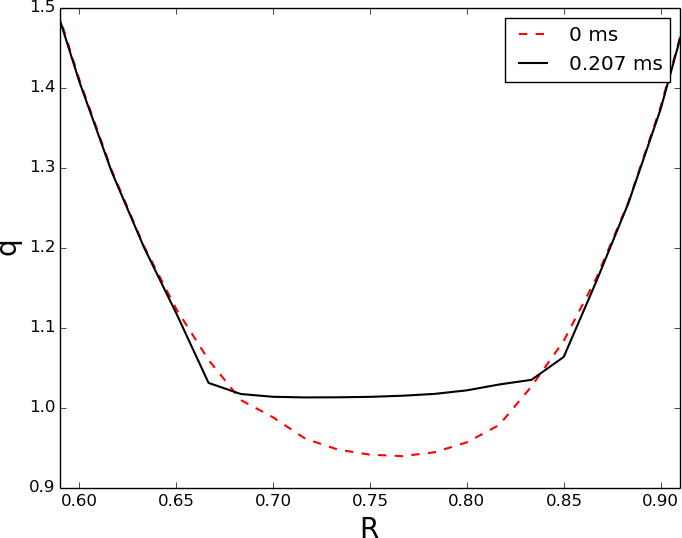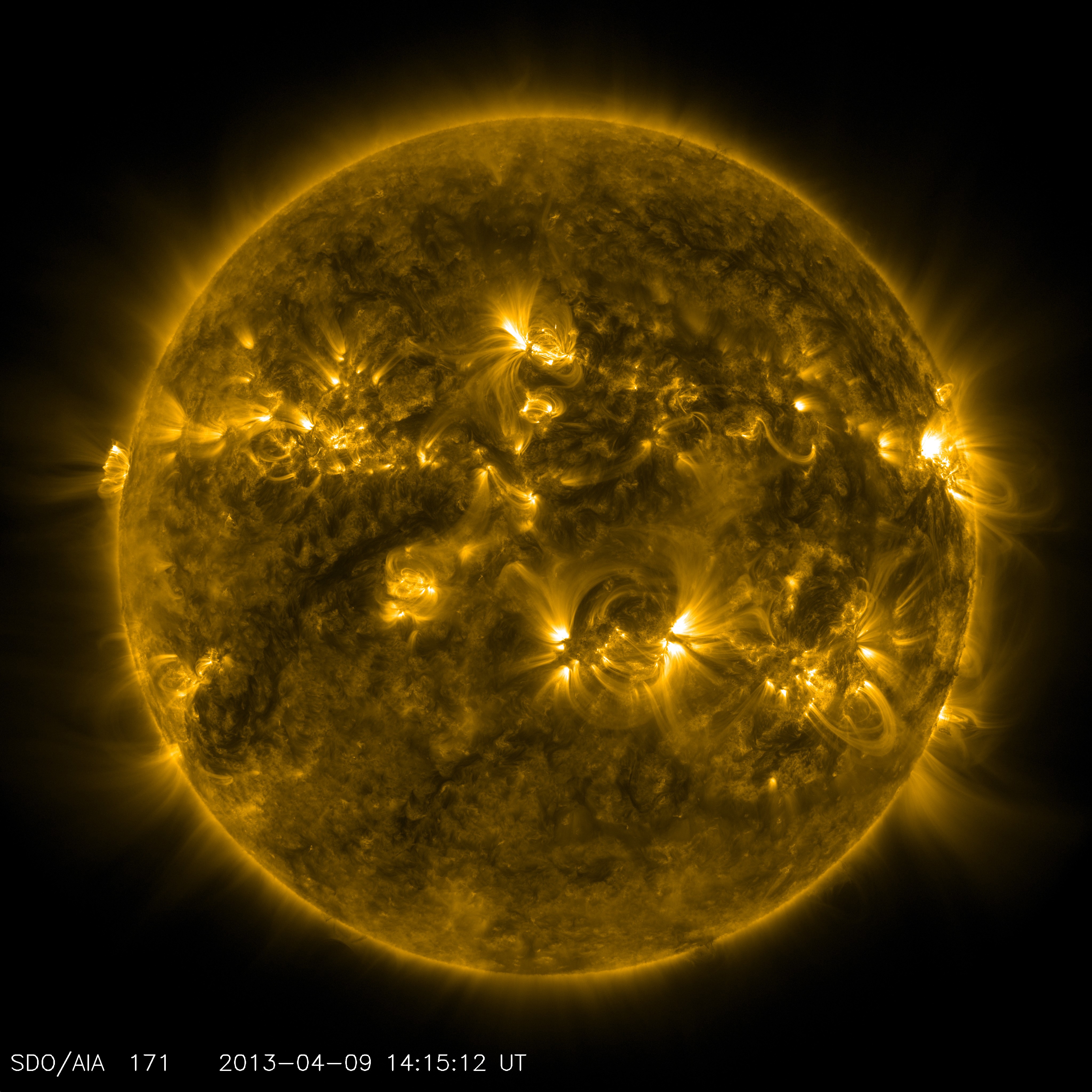|
Tokamak Sawtooth
A sawtooth is a relaxation that is commonly observed in the core of tokamak plasmas, first reported in 1974. The relaxations occur quasi-periodically and cause a sudden drop in the temperature and density in the center of the plasma. A soft-xray pinhole camera pointed toward the plasma core during sawtooth activity will produce a sawtooth-like signal. Sawteeth effectively limit the amplitude of the central current density. The Kadomtsev model of sawteeth is a classic example of magnetic reconnection. Other repeated relaxation oscillations occurring in tokamaks include the edge localized mode (ELM) which effectively limits the pressure gradient at the plasma edge and the fishbone instability which effectively limits the density and pressure of fast particles. Kadomtsev model An often cited description of the sawtooth relaxation is that by Kadomtsev. The Kadomtsev model uses a resistive magnetohydrodynamic (MHD) description of the plasma. If the amplitude of the current density ... [...More Info...] [...Related Items...] OR: [Wikipedia] [Google] [Baidu] |
Sawtooth Reconnection
Sawtooth may refer to: Science and technology * Tooth of a saw blade (original meaning) * Sawtooth wave, a type of waveform * Sawtooth (cellular automaton) * Tokamak sawtooth, a phenomenon in plasma physics * Sawtooth, code name for the Power Mac G4 * Sawtooth coriander, a herb also called Culantro * Sawtooth eel * Sawtooth Software Arts and media * Sawtooth (film), a 2004 American thriller and drama film * ''Sawtooth'' (album), an album by British electronic musician Jonny L Places * The Sawtooth, between Mount Evans and Mount Bierstadt in Colorado, United States * Sawtooth Bridges, rail viaducts on Northeast Corridor in Kearny, New Jersey * Sawtooth City, Idaho, United States * Sawtooth National Forest, Idaho, United States * Sawtooth National Recreation Area, Idaho, United States * Sawtooth Wilderness The Sawtooth Wilderness is a federally-protected wilderness area that covers of the state of Idaho. Managed by the U.S. Forest Service in the U.S. Department of Agricultur ... [...More Info...] [...Related Items...] OR: [Wikipedia] [Google] [Baidu] |
Tokamak
A tokamak (; russian: токамáк; otk, 𐱃𐰸𐰢𐰴, Toḳamaḳ) is a device which uses a powerful magnetic field to confine plasma in the shape of a torus. The tokamak is one of several types of magnetic confinement devices being developed to produce controlled thermonuclear fusion power. , it was the leading candidate for a practical fusion reactor. Tokamaks were initially conceptualized in the 1950s by Soviet physicists Igor Tamm and Andrei Sakharov, inspired by a letter by Oleg Lavrentiev. The first working tokamak was attributed to the work of Natan Yavlinsky on the T-1 in 1958. It had been demonstrated that a stable plasma equilibrium requires magnetic field lines that wind around the torus in a helix. Devices like the z-pinch and stellarator had attempted this, but demonstrated serious instabilities. It was the development of the concept now known as the safety factor (labelled ''q'' in mathematical notation) that guided tokamak development; by arranging the ... [...More Info...] [...Related Items...] OR: [Wikipedia] [Google] [Baidu] |
Plasma (physics)
Plasma () 1, where \nu_ is the electron gyrofrequency and \nu_ is the electron collision rate. It is often the case that the electrons are magnetized while the ions are not. Magnetized plasmas are ''anisotropic'', meaning that their properties in the direction parallel to the magnetic field are different from those perpendicular to it. While electric fields in plasmas are usually small due to the plasma high conductivity, the electric field associated with a plasma moving with velocity \mathbf in the magnetic field \mathbf is given by the usual Lorentz force, Lorentz formula \mathbf = -\mathbf\times\mathbf, and is not affected by Debye shielding. Mathematical descriptions To completely describe the state of a plasma, all of the particle locations and velocities that describe the electromagnetic field in the plasma region would need to be written down. However, it is generally not practical or necessary to keep track of all the particles in a plasma. Therefore, plasma physicist ... [...More Info...] [...Related Items...] OR: [Wikipedia] [Google] [Baidu] |
Sawtooth Wave
The sawtooth wave (or saw wave) is a kind of non-sinusoidal waveform. It is so named based on its resemblance to the teeth of a plain-toothed saw with a zero rake angle. A single sawtooth, or an intermittently triggered sawtooth, is called a ramp waveform. The convention is that a sawtooth wave ramps upward and then sharply drops. In a reverse (or inverse) sawtooth wave, the wave ramps downward and then sharply rises. It can also be considered the extreme case of an asymmetric triangle wave. The equivalent piecewise linear functions x(t) = t - \lfloor t \rfloor x(t) = t \bmod 1 based on the floor function of time ''t'' is an example of a sawtooth wave with period 1. A more general form, in the range −1 to 1, and with period ''p'', is 2\left( - \left\lfloor + \right\rfloor\right) This sawtooth function has the same phase as the sine function. While a square wave is constructed from only odd harmonics, a sawtooth wave's sound is harsh and clear and its spectrum contai ... [...More Info...] [...Related Items...] OR: [Wikipedia] [Google] [Baidu] |
Magnetic Reconnection
Magnetic reconnection is a physical process occurring in highly conducting plasmas in which the magnetic topology is rearranged and magnetic energy is converted to kinetic energy, thermal energy, and particle acceleration. Magnetic reconnection occurs on timescales intermediate between slow resistive diffusion of the magnetic field and fast Alfvénic timescales. The concept of magnetic reconnection was first introduced in 1950 in the PhD thesis of James Dungey to explain the coupling of mass, energy and momentum from the solar wind into Earth's magnetosphere and was published for the first time on the open literature in his seminal paper in 1961. Fundamental principles Magnetic reconnection is a breakdown of "ideal-magnetohydrodynamics" and so of "Alfvén's theorem" (also called the "frozen-in flux theorem") which applies to large-scale regions of a highly-conducting magnetoplasma, for which the Magnetic Reynolds Number is very large: this makes the convective term in th ... [...More Info...] [...Related Items...] OR: [Wikipedia] [Google] [Baidu] |
Edge-localized Mode
An edge-localized mode (ELM) is a disruptive instability occurring in the edge region of a tokamak plasma due to the quasi-periodic relaxation of a transport barrier previously formed during a transition from low to high-confinement mode. This phenomenon was first observed in the ASDEX tokamak in 1981. Diamagnetic effects in the model equations expand the size of the parameter space in which solutions of repeated sawteeth can be recovered compared to a resistive MHD model. An ELM can expel up to 20 percent of the reactor's energy. Issues ELM is a major challenge in magnetic fusion research with tokamaks, as these instabilities can: * damage wall components (in particular divertor plates) by ablating them away due to their extremely high energy transfer rate (GW/m2); * potentially couple or trigger other instabilities, such as the resistive wall mode (RWM) or the neoclassical tearing mode (NTM). Prevention and control A variety of experiments/simulations have attempted to m ... [...More Info...] [...Related Items...] OR: [Wikipedia] [Google] [Baidu] |
Magnetohydrodynamics
Magnetohydrodynamics (MHD; also called magneto-fluid dynamics or hydromagnetics) is the study of the magnetic properties and behaviour of electrically conducting fluids. Examples of such magnetofluids include plasmas, liquid metals, salt water, and electrolytes. The word ''magnetohydrodynamics'' is derived from ' meaning magnetic field, ' meaning water, and ' meaning movement. The field of MHD was initiated by Hannes Alfvén, for which he received the Nobel Prize in Physics in 1970. The fundamental concept behind MHD is that magnetic fields can induce currents in a moving conductive fluid, which in turn polarizes the fluid and reciprocally changes the magnetic field itself. The set of equations that describe MHD are a combination of the Navier–Stokes equations of fluid dynamics and Maxwell’s equations of electromagnetism. These differential equations must be solved simultaneously, either analytically or numerically. History The first record ... [...More Info...] [...Related Items...] OR: [Wikipedia] [Google] [Baidu] |
Safety Factor (plasma Physics)
In a toroidal fusion power reactor, the magnetic fields confining the plasma are formed in a helical shape, winding around the interior of the reactor. The safety factor, labeled q or q(r), is the ratio of the times a particular magnetic field line travels around a toroidal confinement area's "long way" (toroidally) to the "short way" (poloidally). The term "safety" refers to the resulting stability of the plasma; plasmas that rotate around the torus poloidally about the same number of times as toroidally are inherently less susceptible to certain instabilities. The term is most commonly used when referring to tokamak devices. Although the same considerations apply in stellarators, by convention the inverse value is used, the rotational transform, or i. The concept was first developed by Martin David Kruskal and Vitaly Shafranov, who noticed that the plasma in pinch effect reactors would be stable if q was larger than 1. Macroscopically, this implies that the wavelength of the pot ... [...More Info...] [...Related Items...] OR: [Wikipedia] [Google] [Baidu] |
Plasma Stability
The stability of a plasma is an important consideration in the study of plasma physics. When a system containing a plasma is at equilibrium, it is possible for certain parts of the plasma to be disturbed by small perturbative forces acting on it. The stability of the system determines if the perturbations will grow, oscillate, or be damped out. In many cases, a plasma can be treated as a fluid and its stability analyzed with magnetohydrodynamics (MHD). MHD theory is the simplest representation of a plasma, so MHD stability is a necessity for stable devices to be used for nuclear fusion, specifically magnetic fusion energy. There are, however, other types of instabilities, such as velocity-space instabilities in magnetic mirrors and systems with beams. There are also rare cases of systems, e.g. the field-reversed configuration, predicted by MHD to be unstable, but which are observed to be stable, probably due to kinetic effects. Plasma instabilities Plasma instabilities can be ... [...More Info...] [...Related Items...] OR: [Wikipedia] [Google] [Baidu] |
Magnetic Reconnection
Magnetic reconnection is a physical process occurring in highly conducting plasmas in which the magnetic topology is rearranged and magnetic energy is converted to kinetic energy, thermal energy, and particle acceleration. Magnetic reconnection occurs on timescales intermediate between slow resistive diffusion of the magnetic field and fast Alfvénic timescales. The concept of magnetic reconnection was first introduced in 1950 in the PhD thesis of James Dungey to explain the coupling of mass, energy and momentum from the solar wind into Earth's magnetosphere and was published for the first time on the open literature in his seminal paper in 1961. Fundamental principles Magnetic reconnection is a breakdown of "ideal-magnetohydrodynamics" and so of "Alfvén's theorem" (also called the "frozen-in flux theorem") which applies to large-scale regions of a highly-conducting magnetoplasma, for which the Magnetic Reynolds Number is very large: this makes the convective term in th ... [...More Info...] [...Related Items...] OR: [Wikipedia] [Google] [Baidu] |
Lundquist Number
In plasma physics, the Lundquist number (denoted by S) is a dimensionless ratio which compares the timescale of an Alfvén wave crossing to the timescale of resistive diffusion. It is a special case of the magnetic Reynolds number when the Alfvén velocity is the typical velocity scale of the system, and is given by :S = \frac , where L is the typical length scale of the system, \eta is the magnetic diffusivity and v_A is the Alfvén velocity of the plasma. High Lundquist numbers indicate highly conducting plasmas, while low Lundquist numbers indicate more resistive plasmas. Laboratory plasma experiments typically have Lundquist numbers between 10^2-10^8, while in astrophysical situations the Lundquist number can be greater than 10^. Considerations of Lundquist number are especially important in magnetic reconnection. See also * Magnetic Prandtl number * Péclet number In continuum mechanics, the Péclet number (, after Jean Claude Eugène Péclet) is a class of dimensi ... [...More Info...] [...Related Items...] OR: [Wikipedia] [Google] [Baidu] |





